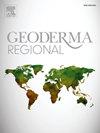Inceptisols中富含蒙脱石的地层引发了热带花岗岩地块的浅层滑坡
IF 3.1
2区 农林科学
Q2 SOIL SCIENCE
引用次数: 0
摘要
2017年飓风“玛丽亚”过后,波多黎各遭受了7万次山体滑坡的影响,山体滑坡的发生率在科迪勒拉中部的乌图阿多地区尤其高。土壤母质为花岗闪长岩的滑坡密度最高;滑坡滑面往往较浅(60厘米),而且往往移动迅速,跳动距离长。本研究将现场观测与土壤矿物学(散装和粘土组分)、土壤地球化学(散装组分)和土壤强度(由现场锥贯仪测试(CPT)确定)相结合,以验证富含粘土的地下土层在淹水时起滑动面作用的假设。在起伏的高原上,Ultisols的土坑挖掘深度为~ 200 cm,在高原侧面的陡坡(36- 430°)上,在Inceptisols的土坑挖掘深度为~ 100 cm,在土坑2 m范围内进行了锥形穿透仪测试(CPT)。六个坑位于先前滑坡的斜坡附近,可以通过外推滑动面来分析向下的土壤剖面。x射线衍射(XRD)、x射线荧光(XRF)和热重分析(TGA)结果表明,土壤具有非均质性,地下层富含粘土矿物和固定元素(Al, Fe, Ti)。陡坡上的初始岩通常含有30-60厘米深的富蒙脱石层,似乎起着滑动面的作用;而在其他的始发岩中,这样的视界并不存在,滑坡的易感性可能较低。在Ultisols中,土壤矿物学以高岭石为主,高岭石含量较少,在某些地点土壤深度≥80 cm处高岭石含量增加,表明潜在的滑面增加了滑坡的可能性。富粘土层的起源似乎是:(1)花岗闪长岩的裂缝,有利于水流和淋滤,在早期风化阶段加速矿物溶解;(2)渗透性崩积层下富含蒙脱石的埋藏土壤,可能是由先前的物质消耗事件沉积而成。如果富粘土层位于透水性较强的层位之下,富粘土层位的快速入渗和吸水会导致抗剪强度降低,增加滑坡易感性。本文章由计算机程序翻译,如有差异,请以英文原文为准。

Smectite-rich horizons in Inceptisols trigger shallow landslides in tropical granitic terranes
Puerto Rico was affected by >70,000 landslides in the wake of 2017 Hurricane Maria, and landslide prevalence was especially high in the Utuado region in the Cordillera Central. Landslide density was highest where soil parent material is granodiorite; landslide slip surfaces tended to be shallow (<60 cm), and often were mobilized rapidly and with long runout distances. This study combines field observations with soil mineralogy (bulk and clay fractions), soil geochemistry (bulk fraction), and soil strength as determined by field cone penetrometer testing (CPT) to test the hypothesis that clay-rich subsoil horizons function as slip planes when water-logged. Soil pits were excavated to depths of ∼200 cm in Ultisols on an undulating plateau and to ∼100 cm in Inceptisols on steep slopes (36-43o) that flank the plateau and cone penetrometer tests (CPT) were done within 2 m of the soil pit. Six pits were located adjacent to scarps from previous landslides, enabling analysis of soil profiles downward through extrapolated slip surfaces. Results from X-ray diffraction (XRD), X-ray fluorescence (XRF) and thermogravimetric analysis (TGA) indicate that soils are heterogeneous, often with subsoil horizons enriched in clay minerals and immobile elements (Al, Fe, Ti). Inceptisols on steep slopes often contain smectite-rich horizons at 30–60 cm depth that appear to function as slip surfaces; in other Inceptisols, such horizons are not present and landslide susceptibility is potentially lower. In Ultisols, soil mineralogy is dominated by kaolinite with minor halloysite, and increased kaolinite content at soil depths ≥80 cm at some sites suggests potential slip surfaces enhancing probability of landslides. The origin of clay-rich horizons appears to be (1) fractures in granodiorite that facilitate water flow and leaching, accelerating mineral dissolution during early weathering stages, and (2) smectite-rich buried soils under permeable colluvium likely deposited by a prior mass wasting event. Where clay-rich layers occur beneath more-permeable horizons, rapid infiltration then absorption of water in clay-rich subsoil horizons causes decreased shear strength and increased landslide susceptibility.
求助全文
通过发布文献求助,成功后即可免费获取论文全文。
去求助
来源期刊

Geoderma Regional
Agricultural and Biological Sciences-Soil Science
CiteScore
6.10
自引率
7.30%
发文量
122
审稿时长
76 days
期刊介绍:
Global issues require studies and solutions on national and regional levels. Geoderma Regional focuses on studies that increase understanding and advance our scientific knowledge of soils in all regions of the world. The journal embraces every aspect of soil science and welcomes reviews of regional progress.
 求助内容:
求助内容: 应助结果提醒方式:
应助结果提醒方式:


